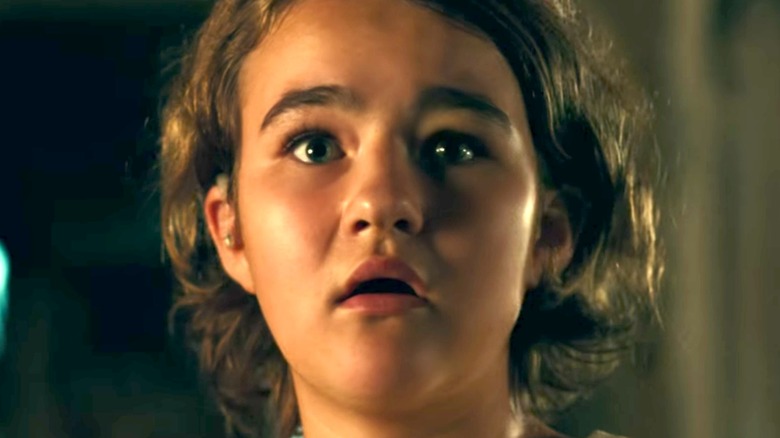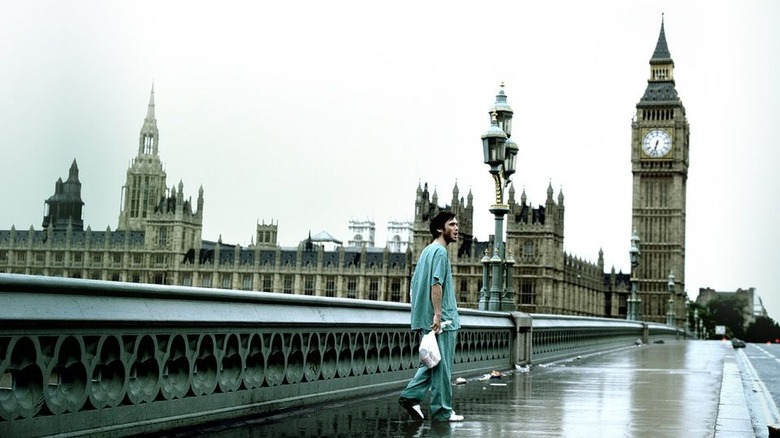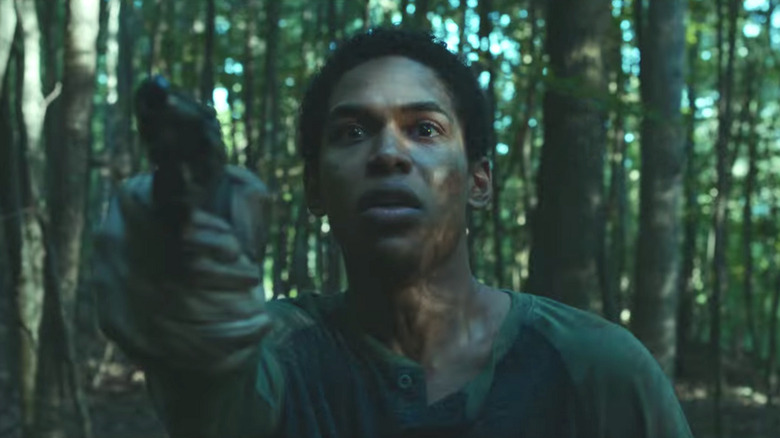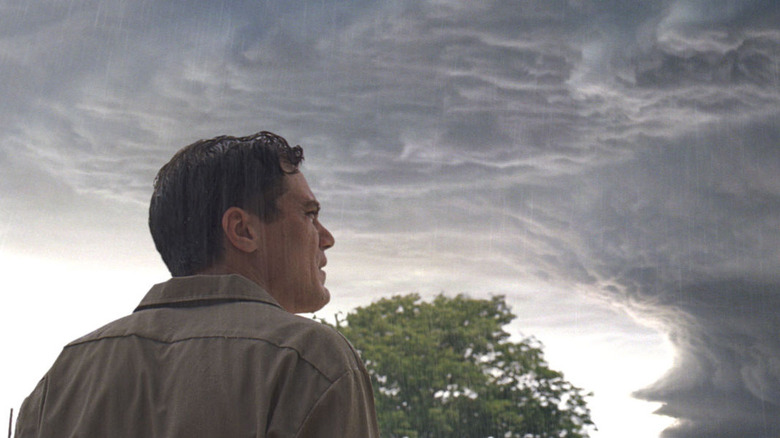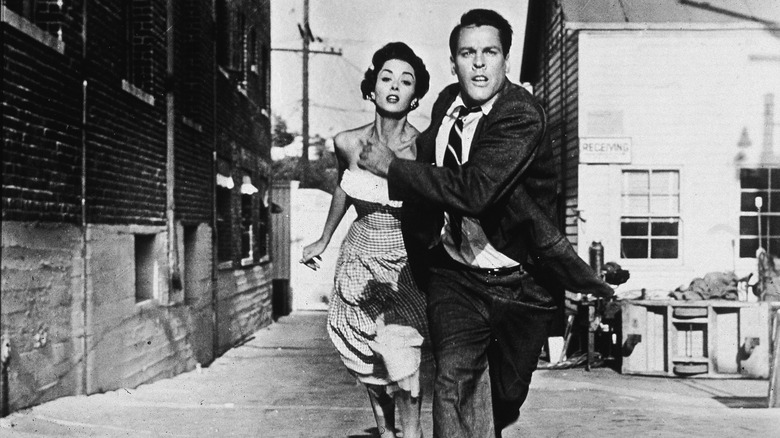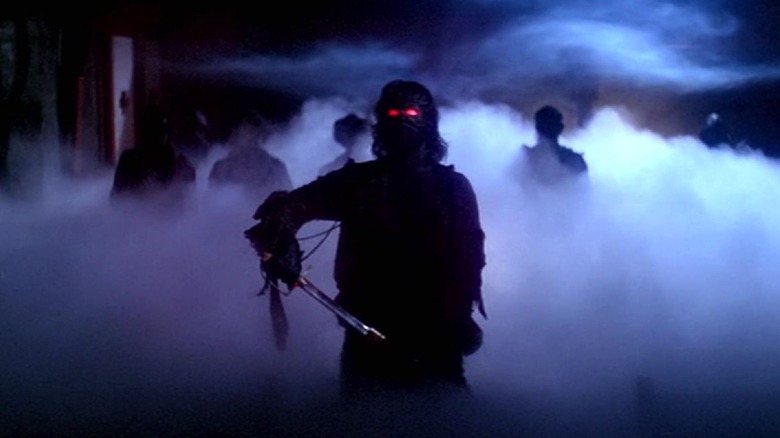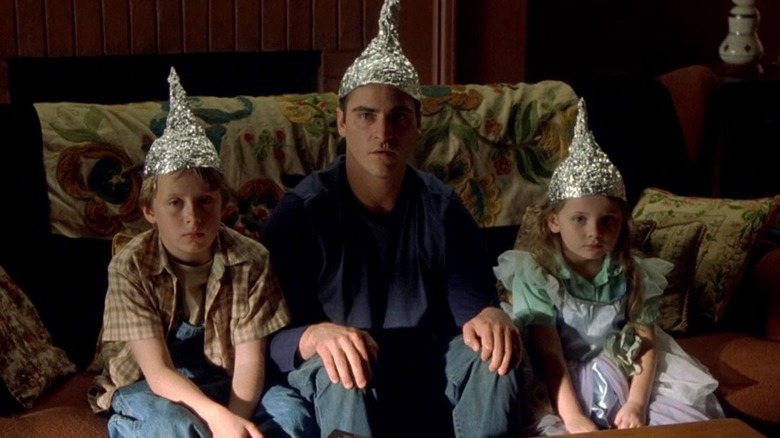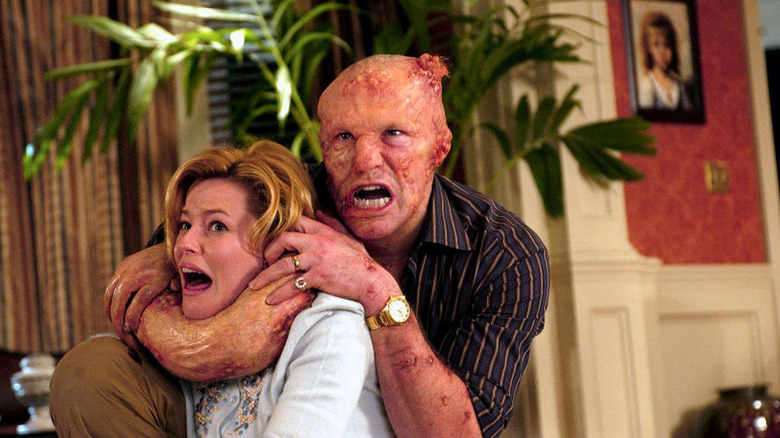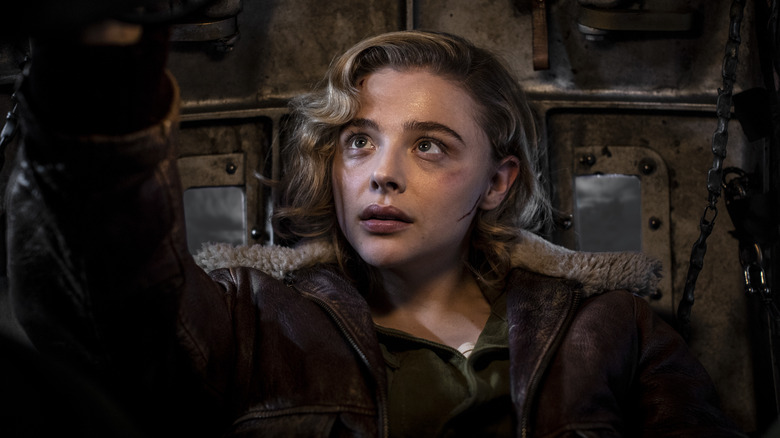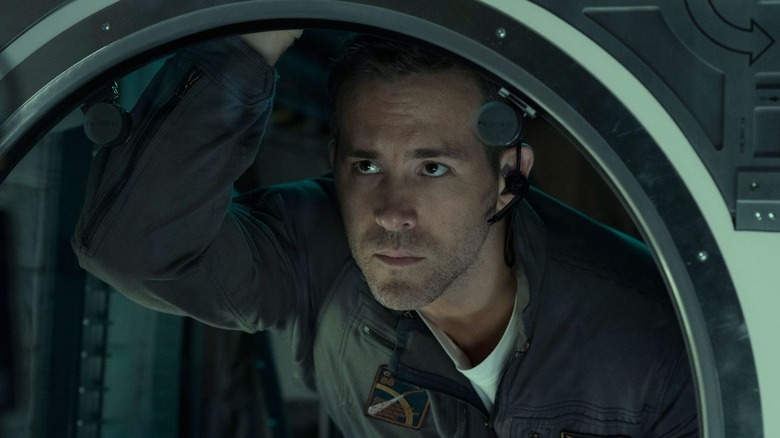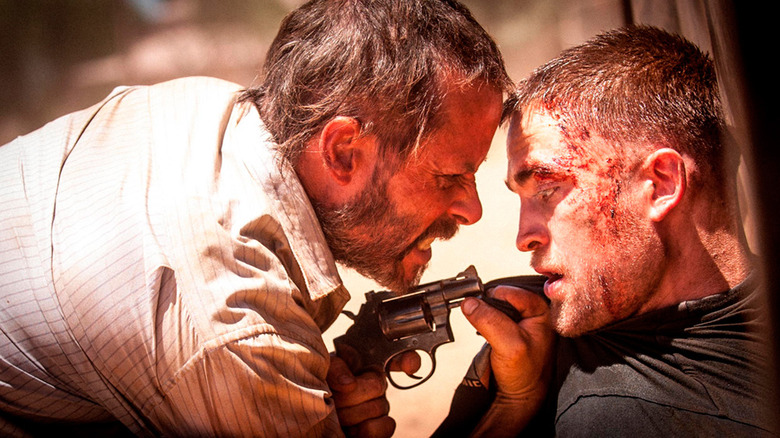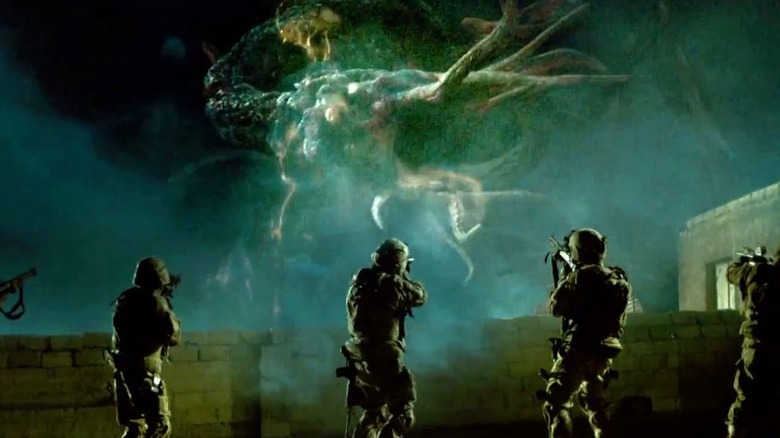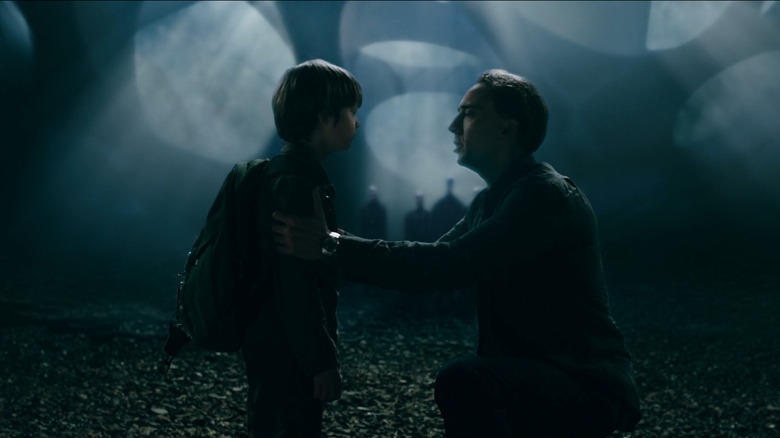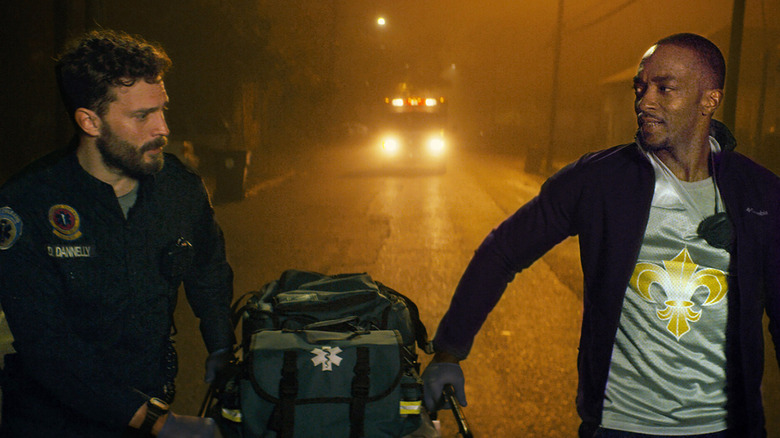13 Movies Like A Quiet Place That Are Definitely Worth Watching
"A Quiet Place" was a refreshing original sci-fi horror movie that became a sensation when it debuted in 2018. It couldn't have come sooner. While great horror films were being produced by indie distributors like A24 and Neon, studio horror films of the time tended to be cheap found footage projects and lazy teen slasher flicks. A change of pace was very welcome.
Director John Krasinski developed the original premise with co-writers Bryan Woods and Scott Beck, crafting a post-apocalyptic world where a fearsome alien race stalks the few remaining humans. The enigmatic creatures are highly attuned to noise, so survivors have to stay as silent as possible to avoid detection. It's a remarkably effective set up — "A Quiet Place" even managed to get obnoxious moviegoers to put away their phones and stop talking once the gripping story started.
Although the concept is brilliant, Krasinski doesn't depict the worldwide impact of the invasion. Instead, the intimate story focuses on just one family as they adjust to life after the crisis. Krasinski and his real wife Emily Blunt brought their natural chemistry to the screen, and Noah Jupe and Millicent Simmons gave breakout performances as their children. 2021's "A Quiet Place: Part II" brought the original cast back for a worthy sequel that lived up to high expectations, but if you want even more movies like "A Quiet Place," check out these films, too.
28 Days Later
The highly influential zombie film "28 Days Later" opens in a similar fashion to "A Quiet Place." Danny Boyle's post-apocalyptic thriller doesn't give many details on how the virus began and doesn't show its spread in depth, and the story picks up once humanity has already been devastated. There are hints at how the government and military are responding to the crisis, but for the most part the film retains its singular focus on a select group of characters.
Jim (Cillian Murphy) wakes up in a London hospital with no idea that the world has been overrun by the infected. After he's rescued by a band of survivors led by Selena (Naomie Harris), the pair trek into the unknown in search of a rescue vehicle. Along the way, they pick up cab driver Frank (Brendan Gleeson) and his daughter Hannah (Megan Burns). "A Quiet Place" showed how an established family adjusted to a dark future; "28 Days Later" shows a new family unit forming as a result of these dire circumstances.
Like "A Quiet Place," "28 Days Later" was praised for its originality. Zombie films had long been under the shadow of George Romero's Living Dead series, and zombie cinema had become just a series of poor Romero impersonators. Boyle and screenwriter Alex Garland made inventive changes to the genre; at the time, fast moving zombies were unique. "28 Days Later" also sparked a new franchise, and although Boyle didn't return, its 2007 sequel "28 Weeks Later" is also quite good.
It Comes at Night
"A Quiet Place" is effective because of how well it fleshes out the family at its center; despite the science fiction scenario, the relationships feel realistic. Obviously, Krasinski and Blunts' marriage makes that pairing a natural transition, but the characters think about and react to the crisis with an inspiring team spirit. The 2017 post-apocalyptic thriller "It Comes at Night" offers a far more pessimistic view of similar dynamics. Arthouse writer-director Trey Edward Shults explores how anxieties forever bond and divide two family clans after an ambiguous global catastrophe.
Paul (Joel Edgerton) and his wife Sarah (Carmen Ejogo) live in a simple cabin in the wilderness with their adolescent son Travis (Kelvin Harrison Jr.), gathering their own food and operating simple technology. Another traveling family, the younger couple Will (Christopher Abbott) and Kim (Riley Keough) and their son Andrew (Griffin Robert Faulkner), cross their path and seek an alliance, hoping to pool their resources. Initially, they're all able to work together, but when things go bump in the night, the characters begin to second guess each other's intentions.
Like Krasinski, Shults doesn't explain any more than he needs to when it comes to the mythology. An event has clearly ravaged the Earth and humanity is in decline, but the limited time dedicated to exploring the backstory leaves more space to develop tension and characterization.
Take Shelter
Krasinski became interested in taking on directorial duties for "A Quiet Place" after becoming a father himself; he described holding his newborn while reading the original script, which he would go on to revise and adapt. Krasinski was moved by the material, and felt that he could empathize with the anxieties of fatherhood that were critical to the film's thematic resonance. These same paternal anxieties are at the center of Jeff Nichols' gorgeous arthouse sci-fi film "Take Shelter."
Set in a small town in Ohio, "Take Shelter" follows the reclusive Curtis LaForche (Michael Shannon) as he experiences strange and haunting dreams that hint at an impending apocalyptic event. Curtis isn't the most outwardly friendly character, but he's incredibly devoted to his wife Samantha (Jessica Chastain) and their deaf daughter Hannah (Tova Stewart). Curtis has always feared how Hannah will adjust to adulthood. Samantha initially suggests that the extreme weather events are natural occurrences, but when strange events occur Curtis galvanizes the town into action.
Nichols brings out an affectionate side to Shannon that isn't always present in his idiosyncratic character parts; Curtis feels the same isolation that Krasinski's character does when the other town residents begin to doubt his story, dismissing his predictions as far-fetched prophecies.
Invasion of the Body Snatchers (1956)
"A Quiet Place" is unique among modern science fiction horror films because it mines more tension from the gradual escalation of danger than elaborate death sequences or moments of brutality. While there are a few jump scares, they have a purpose in the story and don't feel cheap. After all, keeping viewers to the edges of their seats during disorienting, frightening situations is far scarier than a momentary shock. These lessons have been present since the earliest days of science fiction, and the 1956 classic "Invasion of the Body Snatchers" is among the best examples.
This classic social satire follows the slow, secret takeover of a suburban California community by alien invaders. The titular "snatchers" quietly assimilate humans into their ranks, transforming normal people into mindless monsters. Like "A Quiet Place," the scares are silent, and the creatures don't reveal themselves as a threat until it's too late. "Invasion of the Body Snatchers" also benefits from intelligent characters who react realistically. Dr. Miles Bennell (Kevin McCarthy) studies psychiatric delusions, and searches for the origin of mass hysteria with his wife Becky (Dana Wynter) and their group of friends.
The concept of gradual societal decline reflects the Red Scare anxieties of the '50s, and the film's themes are deployed so effectively that the 1978 remake is equally as impactful, serving as a metaphor for the distrust that flourished during the Nixon era.
The Fog
With "A Quiet Place," Krasinski understood that what is unseen is often more frightening than revealing his hand early on. The terrifying early sequence that introduces the family tragedy doesn't show the creatures in detail, and it's well into the film's runtime before they are unveiled in their entirety. The fear of the unknown is something the highly influential writer-director John Carpenter has explored throughout his career; while many of Carpenter's horror films, including "Halloween," "The Thing," and "Christine," center on an iconic threatening figure, his underrated supernatural thriller "The Fog" develops unseen terrors hidden in the shadows. Also like "A Quiet Place," "The Fog" wraps up all its thrills in a tight 90 minutes.
"The Fog" takes place in the coastal California city of Antonio Bay, which has been haunted by sightings of paranormal activity for generations. On the town's centennial anniversary, the kindly priest Father Malone (Hal Holbrook) discovers mysterious diary pages that hint at the town's founders' hidden history and their sabotage of a clipper ship. These early crimes haunt a new generation of characters, including Stevie Wayne (Adrienne Barbeau), Nick Castle (Tom Atkins), and Elizabeth Solley (Jamie Lee Curtis). Curtis worked with Carpenter extensively, and her earnestness provides a great contrast to the creeping tension that he establishes.
Signs
"A Quiet Place" explores the healing that a family goes through as they recover from a devastating loss. The death of four-year-old Beau Abbott (Cade Woodward) in the film's haunting opening sequence doesn't just reveal the film's stakes; it complicates the relationship between Lee (Krasinski) and Regan (Simmons), and makes the Abbot children question their parents' decision to have another child. The family is in mourning even as they fight off extraterrestrial creatures.
These themes are pertinent to M. Night Shyamalan's 2002 sci-fi thriller "Signs," another film that explores a global alien invasion through the eyes of a single family. Graham Hess (Mel Gibson) is a former priest who gave up his faith after the tragic passing of his wife. Graham's brother Merill (Joaquin Phoenix) lives with him, and helps raise his children, Morgan (Rory Culkin) and Bo (Abigail Breslin), but the kids have grown distant from their father after their mother's death. When mysterious signs of otherworldly danger appear, beginning with crop circles in Graham's yard, the family grows closer than they've ever been.
Slither
The locations in "A Quiet Place" are relatively sparse. While the Abbotts are initially on the run, the bulk of the story takes place on their farm, where technology, monitors, and specially equipped living accommodations offer protection from the creatures hunting them. What's scary is seeing how all of their preparation leads to chaos; the Abbotts never expect their systems to collapse, and the comfort of their home is shattered as the danger escalates.
James Gunn's 2006 horror film "Slither" also shows how a familiar environment can become corrupted when an unexplained presence appears. The sci-fi thriller is set in a suburban community not dissimilar from the one the Abbotts once lived in, as seen in the flashback sequences of "A Quiet Place: Part II." A parasitic undead invasion plagues the community's residents, including the eccentric Gary Grant (Michael Rooker). Grant's wife Starla (Elizabeth Banks) harbors a secret crush on Police Captain Bill Pardy (Nathan Fillion), who investigates the mysterious disappearances.
Although Gunn's tone is satirical, the gore and creature effects in "Slither" are truly grotesque. "Slither" is the rare black comedy horror film that's equally funny and scary, and while it was a box office failure, its positive reaction allowed Gunn (director of "Guardians of the Galaxy" and "The Suicide Squad") to continue making bold, creative films with the backing of a studio budget.
Shadow in the Cloud
One of the best aspects of "A Quiet Place" is the time it spends on its female characters. Female protagonists are integral to the history of science fiction and horror films, but both genres have a history of degrading and disrespecting women on screen. It's encouraging to see an original sci-fi horror film develop female characters who are as active, aware, and intelligent as Evelyn and Regan.
"A Quiet Place" fans interested in its gender dynamics will want to check out the underrated 2020 film "Shadow in a Cloud." Female filmmaker Roseanne Liang retooled a problematic script with her World War II-era thriller, which, like "A Quiet Place," is set in a contained environment. The period film takes place in 1943, and follows Flight Officer Maude Garrett (Chloe Grace Moretz) as she unexpectedly joins the crew of an American B-17 bomber traveling from New Zealand to Samoa.
Maude carries a secret package and doesn't disclose its contents to the other crew members, who make sexist comments mocking her abilities. Maude is trapped in the gun turret station for the trip's duration; cut off from communication, she's forced to combat a monstrous creature that's attached itself to the wing with only a radio to communicate. The gremlin-esque alien monster almost feels like an early descendant of the Death Angels of "A Quiet Place."
Life
Films designed to launch sequels may be wary of killing off major characters. "A Quiet Place" does not share that hesitation. This is a film willing to off a child in its first few minutes, and Lee's emotional sacrifice at its conclusion carries lots of emotional weight. The tension escalates when the audience knows that characters could die at any moment, something the underrated 2017 sci-fi horror film "Life" uses to maintain some high stakes. Many characters, including those played by established movie stars, are killed off during sudden, unpredictable moments.
After an exploratory vessel discovers evidence of life on Mars, NASA dispatches the crew of the International Space Station to retrieve the organism. Dr. David Jordan (Jake Gyllenhaal), Dr. Miranda North (Rebecca Ferguson), Rory Adams (Ryan Renolds), Sho Murakami (Hiroyuki Sanada), Dr. Hugh Derry (Ariyon Bakare), and Ekaterina Golovkina (Olga Dihovichnaya) discover that the tiny Martian creature, which school children on Earth nickname Calvin, has the ability to rapidly adapt to its environment.
The understaffed astronauts attempt to research Calvin's origins as the creature picks them off one by one, and director Daniel Espionosa gets away with a surprising amount of body horror for a PG-13 rated film. The shocks continue until the final shot, and while screenwriters Rhett Reese and Paul Wernick have teased a follow up, a sequel has yet to be formally announced.
The Rover
The lack of polish in Krasinski's world building for "A Quiet Place" grounded the post-apocalyptic story in reality. He explores what living conditions would actually be like after the government, the military, and the rest of society have completely collapsed. There's little exposition, leaving attentive viewers to pick up on the clues themselves. A trust in the viewers' intelligence and a grim outlook on societal decay are qualities "A Quiet Place" shares with David Michod's dystopian western thriller "The Rover." Its story bears many similarities to the "Mad Max" franchise, but "The Rover" is less action-centric and more methodical in its pacing.
A decade after a global financial meltdown, the former Australian soldier Eric (Guy Pearce) lives alone on the Outback. Eric quietly mourns the death of his family, but springs into action when a gang of outlaws led by Henry (Scoot McNairy) steal his car. Eric takes Henry's younger brother Reynolds (Robert Pattinson) prisoner, forcing the two into a shaky alliance as they travel across the stark desert landscape.
It's a cold, abandoned universe, and Pearce's steely outlook makes "The Rover" feel even more hopeless. Pearce is heartbreakingly stoic; the film also teased Pattinson's potential in one of his first dramatic roles after the "Twilight" franchise concluded.
Monsters
"A Quiet Place" is a tear-jerking film thanks to its instantly likable characters; Regan has a compelling character arc as she wrestles with her internal guilt and learns to accept her father's love. While the brilliant and simple concept certainly helped turn "A Quiet Place" into a box office hit, it was the emotional resonance that solidified it as a future classic. In his directorial debut "Monsters," future "Godzilla" and "Rogue One: A Star Wars Story" director Gareth Edwards crafted a story about a powerful friendship set amid an apocalyptic disaster.
Photographer Andrew Kaulder (Scoot McNairy) is assigned to rescue his boss' daughter Samantha Wynden (Whitney Able). He's already become jaded by mankind's selfishness, and doesn't care either way what Samantha's fate is, but the potential rewards are enough to spark his interest. Upon encountering the privileged girl, Kaulder is surprised when he finds that he's able to open up to her. "Monsters" depicts the rest of humanity with similar empathy as the pair travel across the Mexican border and meet other survivors.
McNairy shows Kaulder's growth as he shares his past with Wylden, revealing heartbreaking intimate details about what he's experienced. Unfortunately, while "A Quiet Place" was able to launch a successful shared universe, the 2014 "Monsters" sequel "Dark Continent" did not live up to its potential.
Knowing
There's a real sense of urgency to the central mystery of "A Quiet Place." Obviously, one family isn't going to single-handedly defeat an entire alien race, but learning their weakness could help other survivors build a sustainable future. A similar dramatic gravity is present in Alex Proyas' divisive 2009 film "Knowing"; the film may have been criticized for its unusual twist ending, but it was ultimately reappraised by film scholars like Roger Ebert. While "Knowing" is set during modern times, it teases the ultimatum of a worldwide massacre.
Astrophysics professor John Koestler (Nicolas Cage) cares for his young son Caleb (Chandler Canterbury) after his wife's passing, and sees the opening of Caleb's elementary school time capsule as an opportunity for both of them to focus on something other than their loss. However, the discovery of the children's accounts from the 1959 capsule reveals hidden patterns that predict a series of disasters. After a sudden train crash and an inexplicable subway collapse, Koestler becomes obsessed with analyzing the clues before the third catastrophic event occurs.
Synchronic
"A Quiet Place" is uniquely stylized. While Krasinski is indebted to influences like Stephen King, Steven Spielberg, and Ridley Scott, he also developed a cinematic voice of his own. It's exciting when a bold director creates their own idiosyncrasies, especially when they're telling original stories. Directors Justin Benson and Aaron Moorhead have established a niche within elevated genre fare with their films "Resolution," "Spring," and "The Endless," and their 2019 time-travel thriller "Synchronic" is their most successful work to date.
Paramedics Steve Denube (Anthony Mackie) and Dennis Dannelly (Jamie Dornan) think that they're just dealing with an unusually high number of overdoses, but discover that a new drug called Synchronic has claimed multiple lives during their New Orleans night shift. Further research indicates that the narcotic allows users to experience time out of sequence. The film hides details about the characters' exposure to the drug throughout, and the latent details hidden early on make "Synchronic" very rewatchable as a result
